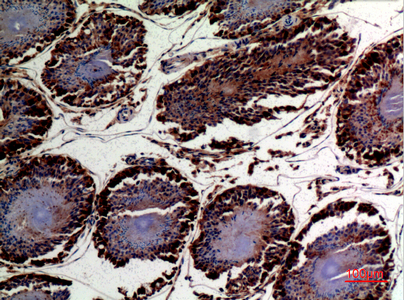HSP40-4 Polyclonal Antibody
- SPECIFICATION
- CITATIONS
- PROTOCOLS
- BACKGROUND

Application
| WB, IHC-P |
|---|---|
| Primary Accession | P31689 |
| Reactivity | Human, Mouse, Rat |
| Host | Rabbit |
| Clonality | Polyclonal |
| Calculated MW | 44868 Da |
| Gene ID | 3301 |
|---|---|
| Other Names | DNAJA1; DNAJ2; HDJ2; HSJ2; HSPF4; DnaJ homolog subfamily A member 1; DnaJ protein homolog 2; HSDJ; Heat shock 40 kDa protein 4; Heat shock protein J2; HSJ-2; Human DnaJ protein 2; hDj-2 |
| Dilution | WB~~Western Blot: 1/500 - 1/2000. IHC-p: 1:100-300 ELISA: 1/20000. Not yet tested in other applications. |
| Format | Liquid in PBS containing 50% glycerol, 0.5% BSA and 0.09% (W/V) sodium azide. |
| Storage Conditions | -20℃ |
| Name | DNAJA1 |
|---|---|
| Synonyms | DNAJ2, HDJ2, HSJ2, HSPF4 |
| Function | Co-chaperone for HSPA8/Hsc70 (PubMed:10816573). Stimulates ATP hydrolysis, but not the folding of unfolded proteins mediated by HSPA1A (in vitro) (PubMed:24318877). Plays a role in protein transport into mitochondria via its role as co-chaperone. Functions as a co- chaperone for HSPA1B and negatively regulates the translocation of BAX from the cytosol to mitochondria in response to cellular stress, thereby protecting cells against apoptosis (PubMed:14752510). Promotes apoptosis in response to cellular stress mediated by exposure to anisomycin or UV (PubMed:24512202). |
| Cellular Location | Membrane; Lipid- anchor. Cytoplasm. Microsome. Nucleus. Cytoplasm, perinuclear region. Mitochondrion Note=Primarily associated with microsomes. A minor proportion is associated with mitochondria (By similarity). Primarily cytoplasmic. A minor proportion is associated with nuclei. |
| Tissue Location | Ubiquitous. Isoform 2 is highly expressed in testis and lung, but detected at low levels in thymus, prostate, colon and liver. |

Thousands of laboratories across the world have published research that depended on the performance of antibodies from Abcepta to advance their research. Check out links to articles that cite our products in major peer-reviewed journals, organized by research category.
info@abcepta.com, and receive a free "I Love Antibodies" mug.
Provided below are standard protocols that you may find useful for product applications.
Background
Co-chaperone for HSPA8/Hsc70 (PubMed:10816573). Stimulates ATP hydrolysis, but not the folding of unfolded proteins mediated by HSPA1A (in vitro) (PubMed:24318877). Plays a role in protein transport into mitochondria via its role as co- chaperone. Functions as co-chaperone for HSPA1B and negatively regulates the translocation of BAX from the cytosol to mitochondria in response to cellular stress, thereby protecting cells against apoptosis (PubMed:14752510). Promotes apoptosis in response to cellular stress mediated by exposure to anisomycin or UV (PubMed:24512202).
If you have used an Abcepta product and would like to share how it has performed, please click on the "Submit Review" button and provide the requested information. Our staff will examine and post your review and contact you if needed.
If you have any additional inquiries please email technical services at tech@abcepta.com.













 Foundational characteristics of cancer include proliferation, angiogenesis, migration, evasion of apoptosis, and cellular immortality. Find key markers for these cellular processes and antibodies to detect them.
Foundational characteristics of cancer include proliferation, angiogenesis, migration, evasion of apoptosis, and cellular immortality. Find key markers for these cellular processes and antibodies to detect them. The SUMOplot™ Analysis Program predicts and scores sumoylation sites in your protein. SUMOylation is a post-translational modification involved in various cellular processes, such as nuclear-cytosolic transport, transcriptional regulation, apoptosis, protein stability, response to stress, and progression through the cell cycle.
The SUMOplot™ Analysis Program predicts and scores sumoylation sites in your protein. SUMOylation is a post-translational modification involved in various cellular processes, such as nuclear-cytosolic transport, transcriptional regulation, apoptosis, protein stability, response to stress, and progression through the cell cycle. The Autophagy Receptor Motif Plotter predicts and scores autophagy receptor binding sites in your protein. Identifying proteins connected to this pathway is critical to understanding the role of autophagy in physiological as well as pathological processes such as development, differentiation, neurodegenerative diseases, stress, infection, and cancer.
The Autophagy Receptor Motif Plotter predicts and scores autophagy receptor binding sites in your protein. Identifying proteins connected to this pathway is critical to understanding the role of autophagy in physiological as well as pathological processes such as development, differentiation, neurodegenerative diseases, stress, infection, and cancer.

.jpg)


